Connected to establish electrical continuity and conductivity – Electrical continuity and conductivity, fundamental concepts in the realm of electricity, play a pivotal role in ensuring the seamless flow of electrical current. This comprehensive guide delves into the intricacies of electrical continuity and conductivity, exploring their significance, methods of establishment, testing techniques, and troubleshooting strategies.
As we navigate through this discourse, we will uncover the diverse applications of these principles, shedding light on their indispensable nature in various industries.
Electrical continuity, the uninterrupted path for electron movement, is crucial for the proper functioning of electrical circuits. Conductivity, on the other hand, quantifies the ability of a material to facilitate the flow of electrical charge. Understanding the principles governing these concepts is paramount for electrical engineers, technicians, and anyone seeking to comprehend the foundations of electricity.
Electrical Continuity and Conductivity: Connected To Establish Electrical Continuity And Conductivity

Electrical continuity refers to the ability of an electrical circuit to allow the flow of electric current without any interruption. Electrical conductivity, on the other hand, is the ability of a material to conduct electricity. Both electrical continuity and conductivity are essential for the proper functioning of electrical systems.
Importance of Establishing Electrical Continuity and Conductivity
Establishing electrical continuity and conductivity is important for a number of reasons. First, it ensures that electrical current can flow safely and efficiently through a circuit. Without electrical continuity, current will not be able to flow, and the circuit will not function properly.
Second, electrical conductivity is important for ensuring that electrical devices and components can operate properly. If a material does not have sufficient electrical conductivity, it will not be able to conduct electricity effectively, and the device or component will not function properly.
Examples of Electrical Continuity and Conductivity, Connected to establish electrical continuity and conductivity
Electrical continuity and conductivity are used in a wide variety of applications. Some examples include:
- Electrical wiring: Electrical continuity is essential for ensuring that electricity can flow safely and efficiently through electrical wiring. Without electrical continuity, the wiring could become a fire hazard.
- Electrical devices: Electrical conductivity is important for ensuring that electrical devices can operate properly. For example, the copper wires in an electric motor are designed to have high electrical conductivity so that they can conduct electricity effectively and power the motor.
- Electrical components: Electrical continuity and conductivity are important for ensuring that electrical components can function properly. For example, the contacts in a switch must have good electrical continuity in order to allow current to flow through the switch.
Expert Answers
What is the difference between electrical continuity and conductivity?
Electrical continuity refers to the presence of an uninterrupted path for electron flow, while conductivity measures the ability of a material to conduct electrical current.
Why is establishing electrical continuity important?
Electrical continuity ensures the proper functioning of electrical circuits by providing a complete path for current flow.
How can I test for electrical continuity?
Electrical continuity can be tested using a multimeter or continuity tester.


